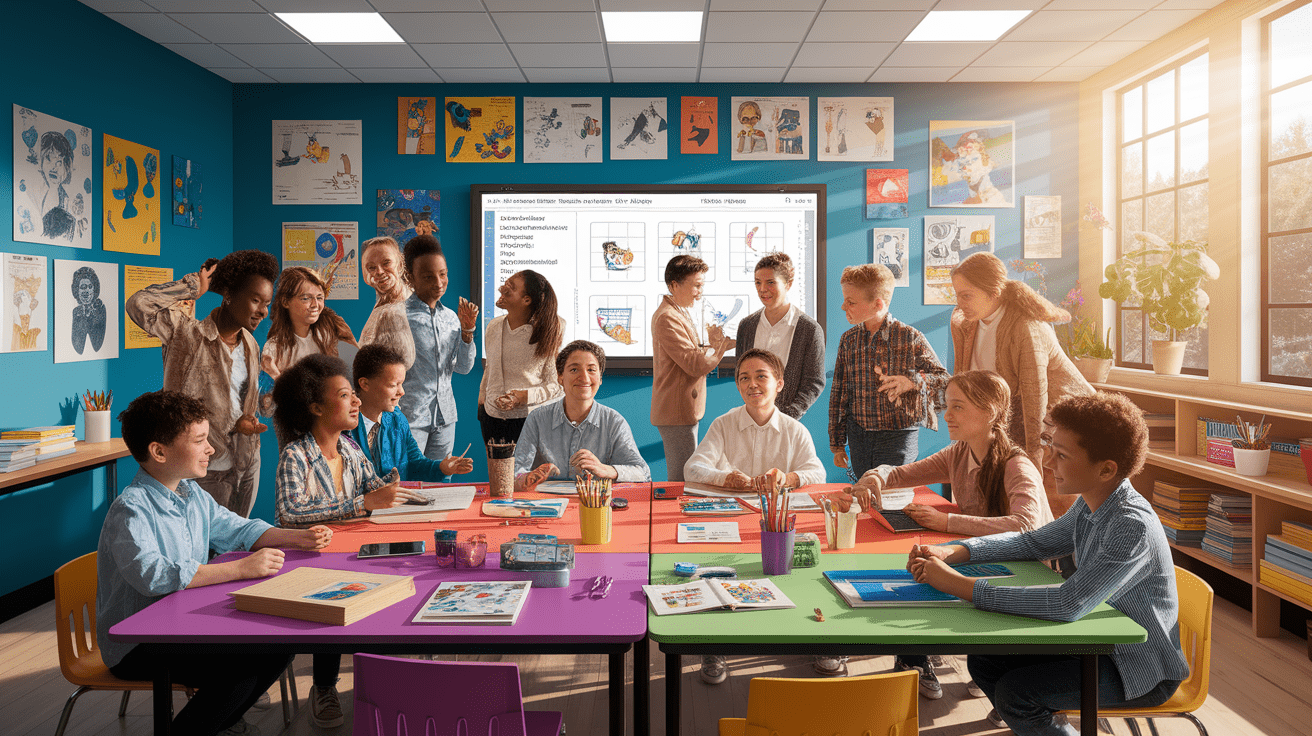Ready to transform your classroom into a buzzing hub of collaborative learning? You’re in the right place! Creating lessons that truly foster teamwork skills and student engagement isn’t just about putting students in groups—it’s about crafting meaningful experiences that build communication skills, critical thinking, and genuine cooperation. Let’s dive into the art of designing lesson plans that make collaborative learning shine!
Planting the Seeds of Collaboration
Before we jump into the nuts and bolts of writing effective lesson plans, let’s establish what collaborative lesson planning really means. Unlike simply dividing tasks among teachers, true collaborative lesson planning involves jointly designing instruction with colleagues, instructional specialists, or cross-disciplinary teams. It requires shared goals, active communication, and equitable participation among all contributors.

Think of a lesson plan as your roadmap—it outlines objectives, methods, and assessments needed to ensure students meet learning targets. But when we design for collaboration, we’re creating something even more powerful: a blueprint for building interpersonal skills alongside academic achievement.
Why Collaborative Learning Matters
The benefits of designing lessons for collaboration extend far beyond the classroom walls. For teachers, collaborative lesson design reduces workload through shared responsibility for curriculum development and resource creation. It enhances pedagogical skills by improving our understanding of subject matter, classroom management, and differentiated instruction strategies.
For students, collaborative learning creates smoother transitions as teachers align conceptual understanding, making it easier to bridge prior learning with new material. When we plan together, we can anticipate misconceptions and make proactive lesson adjustments that support diverse learning needs.
At the institutional level, collaborative planning fosters a culture of trust and encourages professional dialogue. Leaders gain confidence knowing all classrooms are implementing aligned strategies effectively, creating measurable outcomes across grade levels.
Blueprinting Collaborative Success
Now that we’ve planted the seeds, let’s talk about the architecture of successful collaborative lessons. The key is focusing on pedagogy over resources—prioritizing aligned teaching methods and outcomes rather than merely exchanging materials.

Creating “Group-Worthy” Tasks
Not all activities are created equal when it comes to fostering genuine collaboration. Group-worthy tasks require collective problem-solving, critical thinking, and role differentiation. Here’s what makes a task truly collaborative:
- STEM Projects: Students collaborate to design solutions using shared data and collective expertise
- Cross-Curricular Units: Interdisciplinary teams integrate science, math, and language arts into project-based learning (PBL) tasks
- Real-World Problem Solving: Challenges that mirror authentic workplace collaboration
When creating powerful lesson plan goals and objectives, ensure they require students to work together meaningfully, not just sit together.
Understanding Group Work vs. Team Work
Let’s clear up a common confusion! There’s a significant difference between group work and team work:
- Group Work: Features frequent shifting roles, emphasizes social interaction, and maintains informal team dynamics
- Team Work: Involves defined, specialized roles with outcome-focused accountability and structured collaboration processes
Both have their place in education, but understanding the distinction helps you choose the right approach for your learning objectives.
The 4-Step Framework for Collaborative Success
Here’s a practical framework that balances collaboration with academic rigor:
- Draft Tasks: Ensure assignments genuinely require teamwork
- Model Collaboration: Demonstrate roles and best practices
- Guide During Work: Provide scaffolding for peer evaluation and feedback
- Reflect Post-Tasks: Debrief to highlight learning insights and process improvements
Putting Plans into Practice
Implementation is where the magic happens! Effective instructional strategies for collaborative learning require careful attention to structure and support.

Establishing Clear Group Roles
Using roles to improve student collaboration in the classroom is one of the most effective strategies for ensuring equitable participation. Consider these essential roles:
- Leader: Facilitates discussion and keeps the group on task
- Recorder: Documents ideas and maintains group notes
- Timekeeper: Manages pacing and deadlines
- Resource Manager: Organizes materials and technology tools
Rotate these roles regularly to develop well-rounded teamwork skills in all students.
Integrating Technology for Enhanced Collaboration
Learning Management Systems (LMS) like Canvas, Google Classroom, and Moodle offer fantastic opportunities for creating engaging group tasks for online learning. Platforms like Edpuzzle allow for interactive video collaboration, while shared documents enable real-time cooperative learning.
When integrating technology tools to support student collaboration, ensure the technology serves the learning objectives rather than becoming the focus itself.
Assessment-Driven Planning
Formative assessment should be woven throughout your collaborative lessons. Use real-time data to adjust instruction and evaluate collaboration outcomes. This might include:
- Quick check-ins during group work
- Peer evaluation forms
- Individual reflection journals
- Rubrics for group work assessment that measure both process and product
Troubleshooting Team Dynamics
Let’s be honest—not every collaborative experience goes smoothly, and that’s okay! How to manage challenging group dynamics in the classroom is a skill that develops with practice.

Common Challenges and Solutions
Surface-Level Collaboration: When students simply divide tasks without shared planning, they miss opportunities for deeper learning. Combat this by requiring groups to present their collective understanding, not just individual contributions.
Unequal Participation: Some students dominate while others fade into the background. Use structured protocols that ensure everyone contributes, such as round-robin sharing or role rotations.
Social Emotional Learning (SEL) Considerations: Teaching students how to work effectively in a team requires explicit instruction in communication skills and conflict resolution. Don’t assume students naturally know how to collaborate—model and practice these skills!
Supporting Struggling Collaborators
How can you support students who struggle with collaboration? Start with differentiated instruction approaches:
- Provide sentence starters for discussions
- Create visual aids showing collaboration expectations
- Offer alternative ways to contribute (writing, drawing, organizing)
- Use smaller groups initially to build confidence
Remember, collaborative skills develop over time—be patient and celebrate small victories!
Sample Lesson in Action
Let’s see collaboration in action! Here’s a lesson plan example for fostering collaboration in elementary school that demonstrates these principles.
Grade 4 Science: Weather Detectives
Objective: Students will collaborate to analyze weather patterns and create a community weather forecast.
Following the four phases of a lesson plan, here’s how collaboration fits into each stage:
Phase 1 – Introduction (10 minutes): Students watch a collaborative weather forecasting video and discuss how meteorologists work together.
Phase 2 – Development (25 minutes): Teams of four students receive different weather data sets. Each student has a specific role:
- Data Analyst: Interprets temperature readings
- Pattern Detective: Identifies weather trends
- Technology Specialist: Uses online weather tools
- Communication Leader: Prepares team presentations
Phase 3 – Practice (15 minutes): Teams synthesize their data to create a collaborative weather prediction, practicing active learning through peer discussion and problem-solving.
Phase 4 – Assessment (10 minutes): Teams present their forecasts while others provide peer evaluation using a simple rubric focusing on collaboration process and scientific accuracy.
What Makes This Lesson Collaborative?
This lesson exemplifies project-based learning (PBL) by requiring genuine interdependence—no single student can complete the task alone. It develops critical thinking through data analysis while building communication skills through structured presentations.
Harvesting Collaborative Growth
The real measure of successful collaborative lesson design lies in the growth we observe over time. How do we know our efforts are paying off?
Strategies for Assessing Individual Contributions in Group Projects
Balancing individual accountability with group success requires thoughtful assessment strategies:
- Individual Reflections: Students write about their personal contributions and learning
- Peer Evaluation: Structured feedback forms help students assess each other’s collaboration
- Process Portfolios: Document the journey, not just the destination
- Exit Tickets: Quick formative assessment checks after each collaborative session
Building a Culture of Collaboration
Best practices for introducing collaborative learning in a new classroom include starting small and building momentum. Begin with low-stakes activities that allow students to practice teamwork skills before moving to more complex project-based learning.
Create classroom norms that celebrate both individual growth and collective achievement. Display collaborative work prominently and regularly discuss what effective collaboration looks like in action.
Long-Term Impact
When we consistently design lesson plans for differentiated group work, we’re not just teaching content—we’re preparing students for a collaborative world. The interpersonal skills, critical thinking abilities, and teamwork experience they gain will serve them throughout their academic and professional lives.
Remember, designing for collaboration is both an art and a science. It requires patience, practice, and persistence, but the rewards—engaged students, deeper learning, and a more dynamic classroom community—make every effort worthwhile. Keep experimenting, keep reflecting, and keep celebrating the beautiful chaos that comes with genuine collaborative learning!
Your journey in crafting collaborative lesson plans is just beginning. Start with one small change, build on your successes, and watch as your classroom transforms into a space where every student can thrive through the power of working together.




